All
EIA Report: Biofuels are Displacing Petroleum-Based Distillate Fuel Oil Consumption

As reported by the U.S. Energy Information Administration (EIA), consumption of distillate fuel oil in the U.S. West Coast, as measured by product supplied, decreased to its lowest level since 2002 last year and continues its decline this year. The primary cause for the decline is the replacing of petroleum diesel with biofuels, namely renewable diesel, which has gained a larger market share of the region’s diesel pool as clean-fuel programs incentivize biofuels.
West Coast distillate fuel oil consumption decreased in 2022 and is on track to be even lower in 2023 (Figure 1). In five months in 2022, distillate fuel consumption in the region dropped below the 10-year (2012–2021) minimums. In the three months of 2023 published in the EIA’s Petroleum Supply Monthly (PSM), consumption for two months was below 10-year lows, and the average monthly consumption was the lowest for those three months since 2000.
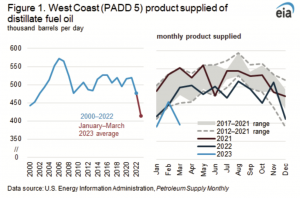
This trend is unique to the West Coast, where most of the United States’ new renewable diesel supply is consumed. Data from the California Air Resources Board and the U.S. Department of Energy’s Alternative Fueling Station Locator suggest that most of this fuel is consumed in California.
In the rest of the United States, distillate fuel oil consumption has been near five-year (2017–2021) averages and has not shown a noticeable trend, aside from returning to pre-pandemic levels (Figure 2). In March 2023, distillate fuel oil consumption in the United States, excluding the West Coast, climbed above its 10-year maximum. This national trend contrasts with that in the West Coast, where consumption dropped below its 10-year minimum. The discrepancy in distillate fuel oil consumption between the West Coast and the rest of the United States demonstrates the general effect of biofuel consumption on distillate fuel oil consumption and indicates most of the renewable diesel produced in the United States is consumed on the West Coast.
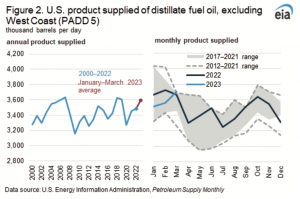
Distillate fuel oil consumption generally decreases with increased biofuel consumption because biofuels displace petroleum diesel fuel, and the EIA captures only a portion of biofuel consumption in its published distillate fuel oil consumption statistics. Since 2021, distillate fuel oil consumption includes three subitems: petroleum diesel fuel; renewable diesel refinery and blender net inputs; and biodiesel refinery and blender net inputs (Figure 3). Refinery and blender net inputs are the amounts of renewable diesel and biodiesel that refiners and blenders report that they blended with petroleum distillate. These volumes are included in the EIA’s distillate fuel oil consumption numbers because they are commingled with the petroleum distillate fuel supply. Although distillate fuel oil product supplied numbers in the PSM include the biofuel volumes that survey responders identify as blending inputs, they do not include the larger volume of biofuel consumption that is not identified as blending inputs. This volume of biofuels is instead accounted for separately as biofuel product supplied, which is especially apparent on the West Coast data because of high biofuel consumption in California, Oregon, and Washington (where clean-fuel programs provide incentives to use biofuels). Prior to 2021, this volume of biofuels was accounted for as distillate fuel oil adjustments, and it was included in distillate fuel oil product supplied.
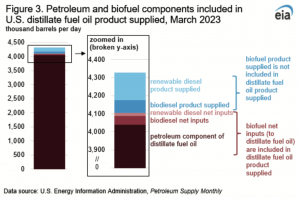
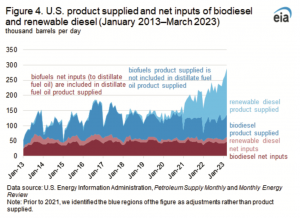
The EIA forecasts that as renewable diesel consumption continues to grow, distillate fuel oil product supplied will continue to decline in the West Coast. Likewise, if renewable diesel consumption extends to other U.S. regions, product supplied of distillate fuel oil are expected to decrease in those regions.
The EIA Short-Term Energy Outlook (STEO) distillate fuel oil consumption forecast aligns with historical product supplied data from the PSM. In other words, the petroleum distillate fuel oil consumption forecast includes biofuel net inputs but not biofuel product supplied. EIA provides a forecast of both renewable diesel consumption and biodiesel consumption. Adding these forecasts to an approximation of petroleum-based distillate fuel consumption (distillate fuel oil product supplied minus renewable fuels except fuel ethanol refinery and blender net inputs) provides a forecast for adjusted distillate fuel oil consumption that includes distillate from both petroleum and biofuels (Figure 5).
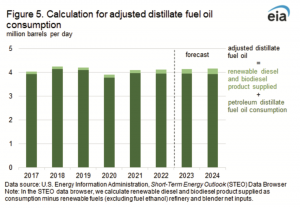
Related Posts
 Why Quality Matters in Your Biofuel Blends
Why Quality Matters in Your Biofuel Blends
Posted on June 25, 2025
 Incorporating Higher Blends of Biofuels
Incorporating Higher Blends of Biofuels
Posted on May 14, 2025
 NORA Programs at Eastern Energy Expo
NORA Programs at Eastern Energy Expo
Posted on May 13, 2025
 March Short-Term Energy Outlook
March Short-Term Energy Outlook
Posted on April 28, 2025
Enter your email to receive important news and article updates.
